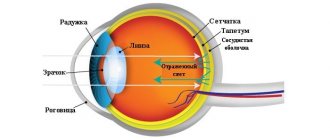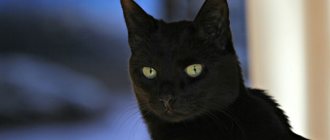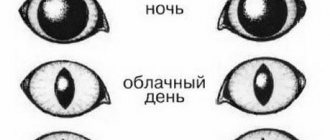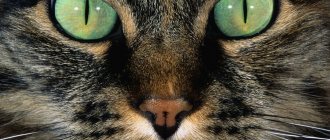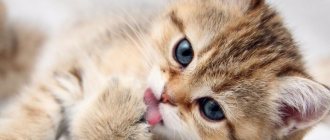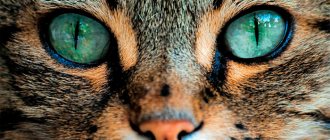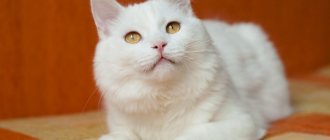Home » Useful Information
From time immemorial, the bewitching look of a cat has been surrounded by numerous beliefs and mystical speculations. Cats are even credited with the ability to see the other world and its inhabitants. To date, not all features of cat vision have been studied by scientists. But some information about how cats see has already been received and confirmed by experts.
- 2 How many colors can cats distinguish?
- 3 How far can he see?
- 4 How they see in the dark
- 5 What is the connection with the other world?
- 6 How they see our world
6.1 Do they see the image on TV and their reflection in the mirror?
- 6.2 How cats see humans
- 7.1 What to do if your cat begins to see poorly
Features of cat vision
The cat's organ of vision differs sharply from the human one in structure and ability to perceive space. They have large, round eyes with a convex lens. The viewing angle of space is 270 degrees.
A special feature of cats is stereoscopic vision. Each eye receives its own image of an object, which is then combined by the brain into one three-dimensional picture. As a result, the predator receives accurate information about the location of the prey and the distance to it.
Everything that the left eye sees goes to the right side of the brain and, conversely, the right eye transmits the picture to the left half
The genetic memory of a predator makes animals react to moving objects. Stationary animals are practically of no interest to them. Watching a moving object, the animal begins to actively move its head up and down: this is how the cat changes its viewing angle and focuses on the prey. This natural ability helps the predator calculate the distance to the prey down to the millimeter, which is why the cat’s jump is so accurate.
The special sensitivity of a cat's eyes is directly related to the structure of the pupil. It is located vertically and has increased elasticity. In bright light, it narrows, limiting rays from reaching the retina. Lack of lighting causes the pupil to dilate greatly, allowing more light to enter.
The sensitivity of a cat's eye is 6–8 times greater than that of a human. The reason for this is a special layer behind the retina called tapetum. It is a shell of vessels that look like mother of pearl.
Peculiarities of color and contrast perception
Compared to humans, color discrimination in cats is much weaker. She distinguishes the contours of objects well, but their colors appear blurry to her, especially at the periphery.
Cat vision occupies an intermediate position between color and black and white. Visual analyzers are insensitive to the average wavelengths of the green part of the spectrum. The whole world is seen in pastel greenish-gray, blue-sand tones, but red, brown and orange are not perceived.
Shades of blue and green appear faded, and purple appears blue. Yellow and blue colors are perceived best by a cat's vision; other shades partially fall out of the picture of the world, being replaced by those closest to them in the color spectrum.
Compared to human eyes, cat eyes not only distinguish shades weaker, but also see everything around them with much less contrast. Their vision is “sharpened” to detect a moving target and correctly estimate the distance to it, which is necessary to calculate the force of a jump during a hunt. Therefore, cats are good at distinguishing moving objects, while stationary ones often escape their attention. For example, an animal may not notice a person standing motionless nearby.
How many colors can cats distinguish?
Until recently, there was an opinion that cats do not distinguish colors. It was assumed that all objects looked gray to them, similar in shades to mice. The main argument for this was that cats simply do not need color vision, because they hunt at night.
Recent research by scientists has refuted this claim. It has been proven that cats cannot distinguish only a few shades: orange, brown, red, green. Their eyes can see blue, violet, gray, and yellow colors. This perception is based on an increased number of cones in the eye, which decipher blue and green colors. There are practically no cones sensitive to shades of red in the eyes of these animals. Therefore, red colors are not available to cats.
Basically, the world from a cat's point of view looks bluish-gray, since they perceive purple and yellow colors less well.
There is no bright picture before the cat’s eyes, but her world is by no means gray
Is the cat colorblind?
An interesting fact is how cats see our world in color. After all, it is known that many animals perceive surrounding objects in black and white shades. This “old” movie doesn’t apply to cats. Fluffy pets are endowed with color vision. However, unlike human color perception, representatives of the cat family do not see all colors, but can distinguish a rich spectrum of tones.
For a long time it was believed that pets can only distinguish many shades of gray (about 25). This theory was based on the fact that cats most often hunt rodents (various species of mice and rats), colored gray-brown. It is shades of gray that a cat can distinguish in low light conditions.
For a full life and successful hunting, it is not necessary for them to identify surrounding objects by color, because the animal does not attach any importance to what shade the object is painted.
When playing with a pet, the question involuntarily arises of how cats see people. No thorough scientific research has been carried out on this matter, but there is an opinion that animals perceive humans through both vision and smell. Some zoologists believe that cats see humans as a larger relative who takes care of them, feeds them and looks after them.
Based on the characteristics of vision, many scientists are inclined to believe that with close contact and at a distance of more than 6 meters, the pet sees the owner as a blurry object and is guided by smell.
The vision of furry pets is a unique, evolutionarily developed survival mechanism in any conditions. Thanks to the unique structure of their visual organs and the ability to recognize potential prey in poor lighting conditions, cats are rightfully considered the most successful hunters among animals. Knowing the peculiarities of our pets’ visual perception of the world around us will help the owner better understand his furry friend.
How far can he see
The maximum distance at which a cat can clearly see objects is 60 meters, but to him an image at such a distance looks like a solid blur. The range of vision is limited to a distance of 20 meters. Scientists explain this feature by the fact that the predator hunts from an ambush, and there is no need to distinguish distant objects.
At too close a distance, cats also do not perceive what is in front of their eyes. An object brought closer to the muzzle than 50 cm is recognized by the animal’s senses of touch. This feature should be kept in mind when playing with your pet.
Domestic predators most clearly see objects located at a distance of 75 cm to 6 m. They need this value to calculate the height and length of the jump for prey.
Color perception
The common belief that cats see the world in black and white is not true. In fact, they are able to distinguish some shades, although the degree of their saturation is not the same as what a person sees. If we can distinguish a lot of color shades, then cats do not have so many of them. Moreover, almost all of them are less saturated and, most likely, even faded, shrouded in a foggy haze.
They can clearly distinguish shades of blue and green, and see gray and smoky tones. These colors are not random; due to photoreceptors, cats have better developed night vision, so the cat’s eyes do not perceive red, bright orange and yellow tones. Or rather, due to the smaller number of cones, the colors will be closer to the tones characteristic of acute night vision. For example, a cat will see yellow as greenish with yellow and gray undertones, but the color will be warm.
The color palette of the animal also includes purple. His pet's vision is not too distorted. It is noteworthy that cats perceive colors in cold temperatures better. However, the spectrum of distinguishable tones directly depends on the degree of illumination; for example, in the evening light, the shades may appear different, so the animal may confuse the same orange with red.
In general, cats have not three, but two types of photoreceptor cones, which are responsible for color daytime vision. It is generally accepted that they are able to distinguish up to 25 shades of gray, but with a color palette the situation is worse than with a neutral one. This gradation is explained by the number of cones responsible for the perception of a particular color.
The percentage of each cone class differs from that of humans. That is why photosensitivity to the components of the solar spectrum is different. However, due to the presence of tapetum, activity in daylight or artificial light is difficult. Moreover, the tapetum itself does not emit light particles, it only reflects those that exist.
In general, in addition to gray, a cat sees 6 primary colors (blue, white, yellowish, green, violet, black), and most clearly of them they perceive blue and violet. Their red and brown merge into one color, which has a grayish admixture. They see it as if the brightness level was reduced in a graphics editor, squeezing the color out of it in favor of neutral colors.
How they see in the dark
The idea that cats navigate in pitch darkness is a myth. The animal sees in minimal light. A cat only needs 10% of the lighting that a human needs. People cannot see anything in such illumination. But this animal is a predator, so its eyes are equipped with additional receptors that have increased sensitivity to light. The tapetum on the back wall of the retina, like a mirror, reflects light twice, which is why cats' eyes glow so much in the dark. In fact, the eyes do not glow, but reflect the rays that hit them.
Cats look at us with multi-colored eyes. Colors like yellow amber, blue sea, blue sky, green grass or bright gold
Good orientation in the space of a dark room is explained by the fact that vision is not the only organ with which cats perceive the world. The secret of the animal is in the especially sensitive organs of touch - vibrissae.
Vibrissae (whiskers) are unique sensors that send information about surrounding objects to the cat’s brain.
Why do cats' eyes glow?
The reason why cats' eyes glow is a special vascular layer called the tapetum lacidum or light curtain.
Natural technology helps cats see in the dark. The light flux entering the eye does not immediately reach the retina, and light is not absorbed by cones and rods. The light beam is reflected onto the “light curtain” and only after that is reflected back onto the retina.
This feature allows cats to see well in the dark, and also provides a “mystical” glow to the animal’s eyes in the presence of a small light source. The eyes of a cat glowing in the dark are nothing more than light reflected from the retina of the eyes.
What is the connection with the other world?
Cats often observe objects that are not visible to humans. They suddenly jump up and start running around the room, knocking them over. At such moments, the animal’s pupils are dilated and its fur stands up. This behavior makes one believe that the cat sees the other world and its inhabitants. His gaze is accessible to what a person is unable to see.
When an animal looks into emptiness or, turning its head, examines an empty wall, there is no reason to worry. This is explained by the fact that even the quietest sounds that are alarming are accessible to a cat’s hearing. They do not come from the other world, but, quite possibly, from under the baseboard. The grandmothers’ assertion that at such moments the domestic predator communicates with the brownie is also from the realm of half-fairy tales.
Over the centuries, cats have been the source of scary stories thanks to their ability to see in the dark.
But the cat’s connection with a world unknown to man still exists. If your pet begins to behave restlessly, for no apparent reason, it is advisable to consecrate the home. Esotericists claim that a cat, having noticed an otherworldly body on its territory, tries to protect its owner from it. First, the animal freezes, trying to assess the “alien”’s intentions. If the cat thinks that the uninvited guest is dangerous for the owner, she tries to force him out with her own energy. When the danger is too strong and the cat cannot cope with it, it may even leave the house. It is not uncommon for cats to return as unexpectedly as they left. So the pet removes evil spirits from the home, and after getting rid of it outside the walls of the house, it returns.
Scientists do not see anything mystical in this behavior of cats and claim that any behavior of a cat is explained by its increased sensitivity to sounds and smells.
But no evidence has been presented to refute the ability of cats to see the inhabitants of the other world, so you can still believe in the supernatural power of a cat’s vision.
Why do they think cats see ghosts?
All owners from time to time notice absurdities in the behavior of their pets. Some are inclined to explain the strangeness precisely by the fact that the cats saw a ghost. “Inappropriate” behavior of animals, when there seems to be no object of attention, manifests itself in the following: - They arch their backs, snort, raise their tails straight up, jump; - they stare intently at one point without moving; - they begin to hiss and run out of the room as fast as they can. rooms; - they play happily with something, running around the room, but there is no toy in their paws; - they get scared, look around or run away, as if someone is chasing them; - they avoid a certain place in the house (corner, piece of furniture and etc.).Are you familiar with such situations? Don’t rush to immediately look for reasons for cats’ behavior in the otherworldly realm. Modern science tends to explain the overwhelming number of such cases quite simply and logically. Smell and hearing
If you are sure that your cat sees ghosts, what we categorically do not recommend doing is immediately contacting psychics. Remember that in addition to her unusual vision, she has very acute hearing. When hunting for mice, a cat relies primarily on sounds from the movements of its intended prey. The human ear is unable to detect this faint sound, but our smaller brothers have a hunting instinct. In addition, our pets are endowed with an amazing sense of smell. In addition to the nose, cats, as scientists have proven, have a so-called “Jacobson's organ”, which is located on the palate. With the help of this “device” our pets sense odors at a great distance. In most cases, this explains the seeming oddities in the behavior of pets. The third explanation for the “strange” actions of representatives of the cat family lies in their character. Even adults are prone to games and the desire to have fun in those moments when it becomes boring. Therefore, jumping, snorting, hissing, etc. may be just a game element.
How they see our world
To see our world through the eyes of a cat, you need to look at a faded, blurry photograph. Nature has provided for the ability of predators to clearly see moving prey without paying attention to small details. A cat's eyes do not provide a complete picture of the world, so their vision is supplemented by other senses.
Cats see immediately with their eyes, nose and vibrissae - sensitive organs located on the face and tail. It is much more important for them to touch and smell an object than to just see it.
Do they see the image on TV and their reflection in the mirror?
Scientists are divided on the perception of images on a TV screen. Some argue that animals see flickering and movement of objects. To confirm this, many owners testify that their pets love watching animals on the screen, and after switching the channel they immediately lose interest in the TV.
Cats not only love to watch TV, but also sleep on it.
Others are sure that TV programs in the eyes of animals look like static pictures replacing each other. They explain this fact by the fact that cat's eyes perceive images at a speed of 40 frames per second. In this case, the TV is configured for human perception, that is, 24 frames. For an animal to see movement on the screen, the frame must be updated 50 times per second.
In the mirror, the cat sees itself normally, but begins to hiss and flatten its ears. This behavior indicates fear. The image without odor and auditory vibrations is incomprehensible and causes fear.
How cats see humans
Pets see people as they are. They adequately assess height, recognize movements and voice. But animals see a clear picture only at a distance of 0.5 to 5 meters. At a distance of 7–10 meters, the pet sees only a silhouette and can recognize the owner by smell and voice.
There is an opinion that, in addition to the physical body of a person, cats can see his biofield. This ability can explain different attitudes towards strangers. The animal approaches some without fear, allows itself to be petted, and even goes into your arms. He doesn't let some strangers come close to him. The animal evaluates a person's aura and accurately determines who may pose a danger to him.
The ability to see the aura is reflected in the cat’s ability to identify a sore spot on the owner’s body. The pet draws out the negative energy of the owner, thereby having a beneficial effect on his health.
If a cat living in a house is constantly sick and no treatment helps, the owners should think about their own health.
By the way a domestic predator looks at a person, you can understand what his mood is at the moment and guess his desires:
- peace and tranquility is expressed by squinting eyes and constricted pupils;
- fear is reflected in wide open eyes and maximally dilated pupils;
- when the pet intends to beg the owner for a treat, the gaze becomes intent, straight into the person’s eyes;
- if an animal, without looking away, looks at a person, periodically slowly closing its eyes, it expresses its love.
Curious facts
Everything that is under the cat’s nose, as they say, is blurry, as if in a haze. Including you, dear owners. The organs of smell and touch – the nose and mustache – help her to love and recognize you up close. And from a distance they will recognize you a hundred paces away.
Compared to the size of the skull, the eyes of cats are simply huge. If people had this, their eyes would be like saucers - 20 centimeters in diameter!
Cats are better at seeing an object that moves horizontally rather than vertically.
Kittens are born blind. And when they open their eyes, they see nothing but light and shadows. Their vision gradually improves over 2 months.
Blind cats can hunt too. Some of the visual functions are taken over by whisker whiskers, which grow not only on the muzzle, but also on the paws.
When a cat sits motionless, staring at a wall, it is not necessarily communicating with spirits. Perhaps she is listening to the sound of a small wood-boring bug rustling under the wallpaper, or trying to understand what the dog on the floor below is doing. After all, the house became suspiciously quiet.
A little more about the features of cat vision in the video:
Vision problems: how to notice them
Cats suffer from various vision disorders quite often. The owner should be wary if the animal hides its eyes from bright light or often rubs its face with its paws. Signs of inflammation are frequent blinking of the pet, pus in the corners of the eyes, clouding of the whites, swelling of the eyelids. Any of these signs is a reason to immediately consult a veterinarian.
Kittens that are blind at an early age have much longer whiskers than their kittens. This is how nature compensates for the lack of visual perception of the world
Some eye diseases can cause complete blindness in your pet. It is difficult to notice vision problems in cats in order to take timely measures, since they are able to navigate in space even with complete blindness. The following signs indicate that vision problems have begun and should be checked:
- the animal does not jump to its favorite places located at a height or, when jumping, misses and falls;
- when moving around the house, he comes across moved or new furniture, objects standing in unusual places;
- your pet’s pupils do not constrict in bright light;
- stops responding to favorite toys;
- when the pet looks at the owner, his gaze does not focus on him.
All these signs indicate a deterioration in the cat’s vision or the onset of blindness.
What to do if your cat begins to see poorly
Unfortunately, it is not always possible to restore a pet’s vision, but this is not a reason to abandon a sick animal. The owner should organize the space of the home in such a way that the animal feels comfortable. Your pet can live a full life if you do the following:
- do not change the location of bowls with food and water;
- do not let the animal out into the street unattended, take it for a walk on a leash;
- in a new room, accustom the cat to the location of objects, without frightening them and allowing them to find their own way;
- do not block the path with boxes, scattered toys and other objects.
Organs that help a cat “see” the world around it
A cat hears much better than a human and easily determines its source due to the ability to turn its ears in different directions. Scientists say that she has an excellent ear for music. Moreover, she recognizes the set of sounds that make up her nickname without difficulty.
Vibrissae - whiskers, which actually act as sensors and are located throughout the animal's body, help the cat navigate in space. They help the animal navigate in complete darkness. This is why cats should not be cut.
The skin also serves as a sensor, and a very powerful one, capable of detecting the slightest changes in temperature. The pads on the paws, genitals and head are especially sensitive.
The sense of smell is very important for pets. Cats can detect many different smells and have about 70,000,000 olfactory cells. They can instantly detect an unpleasant odor. But if the sense of smell has weakened, the cat may even refuse its favorite treat.
The only thing in which a cat is inferior to a human is its taste palette. The animal is able to eat a dish that is too salty, but can distinguish sour food well. She will not be drawn to sweets, since only dogs understand sweet taste well.
Birds
Bird vision is very different from other animals. In a 2007 study, ornithologists discovered that birds are capable of seeing a range of colors far beyond what even humans can see. The experiment showed that birds have two advantages in this area. Firstly, they recognize colors in the ultraviolet spectrum thanks to an additional receptor. It gives birds access to a wide range of colors that are only found in the feather colors of their fellow birds. Mammals generally cannot see these colors because they do not directly encounter them in their natural habitat. Birds also have a special retinal filter necessary to recognize the colors of potential partners and enemies.
Secondly, the viewing angle of domestic parrots (for example, budgerigars) is 360 degrees. No detail will escape your feathered friend. True, parrots see poorly up close and at dusk, so it is recommended to cover the cages with birds at night with a cloth.
Photo by the author
Assessing distant and near views
It is believed that a cat only recognizes objects that are nearby well. Scientists have confirmed that these animals are indeed myopic. They can distinguish objects well only at a distance of up to twenty meters. The cat sees everything that is further away very blurry, without contours or boundaries.
At the same time, the animal also distinguishes objects that are located directly in front of its muzzle or at a distance of up to 0.5 meters. In this case, the mustache and ears help to observe the near world.
The famous researcher and artist Nikolai Lamm was able to take a number of photos that depict how a cat sees the world around him with his own eyes. Cat's eyes are best suited for detecting rapid movements. A person can only notice a sliding shadow, but an animal can see not only in detail the running mouse, but also its route.
The relationship between a cat and a person - do cats love us?
no : But they are connected to us by bonds of affection.
Indeed, the concept of love is very subjective. If we compare a dog, which out of love can risk its life to save its owner, a cat does not have this strong and unique loving relationship between animal and human.
But if a cat doesn't feel love in the strongest sense of the word, it does feel love. affection for you .
This behavior of his may reveal this:
- Un purring cat on your lap
- A cat that kneads you with its paws
- Un the cat that sticks to you , rub your head against yours
- Un cat licks your face
- Un cat bites you
- A cat that offers you its belly in the air
- The cat who sleeps with you
- A cat who wants to play with you
And, of course, you love your cat very much and you can show it to him: How to show a cat that you love her?
What cats see in the mirror and on TV
Sometimes owners laugh and watch as cats comically attack mirrors. As a result, the frightened animal arches its back, bristles its whiskers, and flattens its ears. So what do they see in the mirror? Mustaches see their reflection in the mirror, but they do not understand that they see themselves. They are frightened by the fact that their auditory and tactile receptors do not transmit any information about the presence of another animal. Cats simply cannot form a picture in their heads from the information received.
When it comes to TV, most zoologists say that cats only notice the flickering on the screen. They are fascinated by objects moving on the screen. However, everyone knows that cats love to watch programs about animals; without looking up from the screen, they watch the flight of birds and the hunting of cats. Moreover, they do not come off the screen even when the sound is turned off. As soon as the channel is switched, the animal, having lost interest, leaves the room. Scientists currently cannot give an exact explanation for this fact.
Relationships between people and cats. Does a cat recognize its owner?
yes : Your cat knows very well who you are!
In fact, your cat may know you better than you think. Feline behavior experts, in collaboration with cat owners, confirm that cats very quickly learn the habits of people living in their territory and know how to recognize them.
A cat knows how to recognize a person who cares about feeding him, who will give in to a treat when he meows, a person who calms him down and who knows when he needs affection...
But cats are smart and are also able to recognize what sound or action will trigger the reaction they expect from humans. This is why he will rub against your legs every night when you come home from the office (to ask for food or to ask for a hug...).
